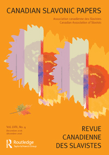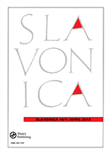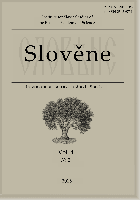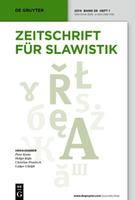
Palaeobulgarica-Starobalgaristika
Scope & Guideline
Charting New Territories in Bulgarian Historical Research
Introduction
Aims and Scopes
- Historical Manuscript Studies:
The journal publishes research that delves into the history, analysis, and significance of historical manuscripts, particularly those related to Old Bulgarian and Slavic texts. - Linguistic Analysis and Translation Studies:
A core focus is on the linguistic characteristics of Old Church Slavonic and its translations, including lexical semantics and terminology. - Cultural and Religious Heritage:
The journal highlights the cultural and religious aspects of the Slavic world, exploring themes related to hagiography, liturgical texts, and the influence of Byzantine traditions. - Paleography and Codicology:
Research on paleographic methods and codicological studies is emphasized, providing insights into manuscript production and textual transmission in the medieval Slavic world. - Interdisciplinary Approaches:
The journal promotes interdisciplinary studies that connect literature, history, linguistics, and cultural studies, fostering a comprehensive understanding of the Slavic heritage.
Trending and Emerging
- Digital Humanities and Technology in Manuscript Studies:
Recent publications highlight the use of digital technologies for analyzing and preserving manuscripts, indicating a trend towards integrating digital tools in traditional scholarship. - Detailed Codicological Studies:
There is an increasing focus on the specifics of manuscript codicology, including the physical attributes of manuscripts and their implications for understanding Slavic literary traditions. - Translational Studies of Religious Texts:
Research examining the nuances of translation in religious texts, particularly the Old Church Slavonic translations, is gaining traction, reflecting its importance in understanding cultural transmission. - Interdisciplinary Studies of Cultural Memory:
Emerging themes include the exploration of cultural memory and the legacy of figures like Cyril and Methodius, illustrating a renewed interest in the interplay between memory, identity, and textual tradition. - Hagiographical Studies:
An increased number of studies focusing on hagiography, particularly in relation to lesser-known saints and their narratives, suggests a revitalization of interest in this genre within Slavic literature.
Declining or Waning
- General Historical Narratives:
There appears to be a waning interest in broad general historical narratives that do not focus on specific texts or linguistic elements, as more scholars opt for targeted studies. - Comparative Studies with Non-Slavic Cultures:
Comparative analyses that involve non-Slavic cultures seem to be less frequent, possibly as the focus narrows to more localized Slavic studies. - Focus on 20th Century Literature:
Research related to 20th-century Slavic literature has decreased, with scholars increasingly prioritizing earlier periods of Slavic history and literature. - Overviews of Slavic Dialects:
Studies that provide broad overviews of Slavic dialects rather than detailed analyses of specific dialectal features have become less common. - Theoretical Linguistic Frameworks:
There is a noticeable decline in papers applying theoretical linguistic frameworks, as practical analyses and historical contexts take precedence.
Similar Journals

Studia Slavica et Balcanica Petropolitana
Exploring the Depths of Slavic and Balkan HeritageStudia Slavica et Balcanica Petropolitana is an esteemed open-access journal, published by the Department of History at St. Petersburg State University, focusing on interdisciplinary research within the fields of Slavic and Balkan studies. Since its inception in 2007, the journal has made significant contributions to the academic discourse surrounding historical and contemporary issues pertinent to these regions, thus achieving a strong reputation among scholars. As of 2023, it is categorized in the Q2 quartile for History, ranked 873 out of 1760 in the arts and humanities segment, highlighting its impactful scholarly contributions. The journal operates out of Russia, with its editorial office located at Mendeleevskaya Liniya in St. Petersburg. Its accessible publishing model promotes widespread dissemination of knowledge, making it an invaluable resource for researchers, professionals, and students who aim to deepen their understanding of Slavic and Balkan societies from both historical and modern perspectives.

Istoriya-History
Decoding the Past for Tomorrow's InsightsIstoriya-History is a reputable academic journal published by NATSIONALNO IZDATELSTVO AZ BUKI, focusing on the rich tapestry of historical analysis and interpretation. With its print ISSN 0861-3710 and E-ISSN 1314-8524, the journal provides a platform for scholars, researchers, and students to publish their work and contribute to the growing body of knowledge in the field of history. Although it operates under a subscription model, the journal aims to make significant historical research accessible to the scholarly community. The journal’s editorial board comprises experienced historians and academics dedicated to ensuring high-quality peer-reviewed articles that uphold rigorous academic standards. With its base in Sofia, Bulgaria, and an emphasis on both regional and global historical discourses, *Istoriya-History* serves as a vital resource for professionals and enthusiasts eager to understand the complexities of the past and its implications for the present and future.

Slavia Meridionalis
Exploring the rich tapestry of Slavic culture and history.Slavia Meridionalis is a distinguished open-access journal published by the Polish Academy of Sciences, Institute of Slavic Studies, dedicated to advancing scholarly discourse in the fields of Anthropology, Cultural Studies, History, Linguistics and Language, and Literature and Literary Theory. With its ISSN 1233-6173 and E-ISSN 2392-2400, this journal has made significant strides in promoting research since its inception in 2014. Operating from Warsaw, Poland, Slavia Meridionalis aims to serve as a pivotal platform for researchers and students alike, fostering interdisciplinary collaboration and knowledge dissemination. The journal holds respectable rankings in its various categories, some achieving Q3 status, which reflects its commitment to quality scholarship within the academic community. By providing open access to its readership, Slavia Meridionalis ensures that pivotal research is readily available for the global audience, thus enhancing its relevance and impact across diverse fields.

Canadian Slavonic Papers
Unveiling Cultural Narratives from the Slavic WorldCanadian Slavonic Papers, published by Routledge Journals, Taylor & Francis Ltd, is an esteemed peer-reviewed journal dedicated to the exploration of the Slavic, Eastern European, and Russian domains, fostering scholarly dialogue across multiple disciplines. With a robust focus on Cultural Studies, History, Linguistics, and Literature, this journal has firmly established its presence in the academic community, as evidenced by its Q1 ranking across various categories in 2023. Since its inception, Canadian Slavonic Papers has been a vital platform for researchers, professionals, and students alike, providing an invaluable repository of knowledge and insights from 1977 to the present. While not an open-access journal, it remains accessible through institutional subscriptions, ensuring a wide dissemination of scholarship. Located in the United Kingdom, the journal continues to contribute significantly to the understanding of Slavic studies within a global context, making it essential reading for anyone invested in this dynamic field.

INDO-IRANIAN JOURNAL
Unveiling the Rich Tapestry of Indo-Iranian StudiesINDO-IRANIAN JOURNAL, published by BRILL, serves as a premier platform for scholarly research within the fields of linguistics, philosophy, and political science. Established in 1957 and continuing through 2024, this journal is unwavering in its commitment to advancing the understanding of Indo-Iranian studies by incorporating a rich diversity of perspectives and methodologies. With an ISSN of 0019-7246 and an E-ISSN of 1572-8536, it is indexed in Scopus and has garnered respectable rankings, including a Q3 classification in both Linguistics and Language and Philosophy for 2023, indicating its significance in the academic community. Although it does not offer open access, the journal prioritizes the dissemination of high-quality research, contributing to the ongoing discourse in these vital areas of study. By fostering a rigorous academic exchange, the INDO-IRANIAN JOURNAL is essential for researchers, professionals, and students dedicated to exploring the intricacies of Indo-Iranian interactions and their broader implications.

SLAVONICA
A Critical Platform for Slavic Studies ScholarshipSLAVONICA is a distinguished academic journal dedicated to the exploration and analysis of Slavic studies, incorporating a wide array of cultural, historical, and linguistic perspectives. Published by Routledge Journals, Taylor & Francis Ltd, this journal serves as a critical platform for interdisciplinary scholarship, emphasizing the dynamic nature of Slavic cultures and languages. Though it currently does not offer Open Access, SLAVONICA is an important resource for researchers, professionals, and students seeking to engage with the latest academic discourse in the fields of Cultural Studies, History, Literature, and Linguistics, achieving a recognized place in the Q4 quartile across several categories as of 2023. With coverage spanning from 1994 to 2024, and its commitment to fostering academic inquiry, SLAVONICA plays a vital role in elevating the understanding of Slavic heritage and contemporary issues, making it essential reading for anyone interested in the complexities of this region.

Gripla
Navigating the Evolving Landscape of Linguistic and Literary ScholarshipGripla, published by the Arni Magnusson Institute for Icelandic Studies, stands as a significant academic journal in the fields of linguistics and literary studies. With an ISSN of 1018-5011, this esteemed journal has been releasing cutting-edge research since its inception in 2011. Although currently categorized as Q4 in Linguistics and Language and Q3 in Literature and Literary Theory for 2023, it has showcased robust scholarship with a Scopus rank of #327 in Literature and Literary Theory, placing it within the 70th percentile of its category. Gripla serves as a vital platform for the exploration of Icelandic studies, fostering a deeper understanding of language and literature in a rapidly evolving academic landscape. While it is not an open-access journal, its contributions are essential for researchers, professionals, and students eager to engage with new developments in the linguistics and literary discourse. Situated in the heart of Reykjavik, Gripla continues to enrich the scholarly community by providing insights that bridge traditional knowledge with contemporary relevance.

Slovene-International Journal of Slavic Studies
Bridging Disciplines in Slavic Cultural ExplorationThe Slovene-International Journal of Slavic Studies, published by the Russian Academy of Sciences, Institute of Slavic Studies, serves as a vital platform for scholarly discourse in the fields of Cultural Studies, History, Linguistics, and Religious Studies. Since its transition to Open Access in 2012, the journal has enriched academic dialogue, enabling wider circulation and accessibility of research findings. Based in the Russian Federation, the journal supports interdisciplinary approaches, inviting contributions that push the boundaries of traditional Slavic studies. With a commendable ranking in the Q3 quartile across multiple categories as of 2023 and respectable Scopus rankings, it stands out as a crucial resource for researchers and students alike, enhancing their understanding of Slavic and related cultural contexts. The journal's commitment to fostering international collaboration and dialogue positions it as an invaluable asset for anyone engaged in the complexities of Slavic studies.

ZEITSCHRIFT FUR SLAWISTIK
Illuminating the Path of Slavic Linguistic InquiryZEITSCHRIFT FUR SLAWISTIK, published by WALTER DE GRUYTER GMBH, is a renowned journal focusing on Slavic studies, encompassing various fields such as cultural studies, linguistics, and literary theory. With its ISSN 0044-3506, this distinguished journal has been a significant contribution to the academic community since its inception in 1956, continuing to disseminate valuable research until 2024. While maintaining a strong reputation within several academic categories, ZEITSCHRIFT FUR SLAWISTIK holds a Q3 ranking in Cultural Studies and Linguistics and Language, and a Q2 ranking in Literature and Literary Theory as of 2023. This positioning underscores the journal’s impact, particularly as it caters to an audience of researchers, professionals, and students invested in the rich tapestry of Slavic culture and language. Access to this journal is not open; however, its comprehensive articles are crucial for anyone aiming to explore and deepen their understanding of Slavic linguistic and literary traditions. The journal's work is essential in fostering cross-disciplinary dialogue and advancing scholarship in these vital areas.

Slavia-Casopis pro Slovanskou Filologii
Advancing Scholarship in Slavic Language and LiteratureSlavia-Casopis pro Slovanskou Filologii is an esteemed journal dedicated to the advancement of Slavic philology, published by the SLOVANSKY USTAV AKAD CESKE REPUBLIKY in the heart of the Czech Republic. With its ISSN: 0037-6736, the journal serves as a vital platform for scholarly exchange, embracing a rich academic tradition since its convergence years beginning in 2002. The journal has achieved notable recognition, with a Q3 ranking in Linguistics and Language and a Q2 in Literature and Literary Theory as of 2023, highlighting its contribution to these dynamic fields. Although it does not currently offer open access, its rigorous selection of articles ensures that it remains a crucial resource for researchers and practitioners alike, facilitating a deeper understanding of Slavic languages and literature. Scholars benefit from the journal's extensive research backdrop, enhanced by its current ranks in the Scopus database, underscoring its significant placement within the academic literature landscape. The editorial scope of Slavia promotes innovative inquiries that reflect cultural, historical, and theoretical perspectives endemic to Slavic studies, making it indispensable for professionals, students, and enthusiasts invested in the exploration of Slavic linguistic and literary heritage.